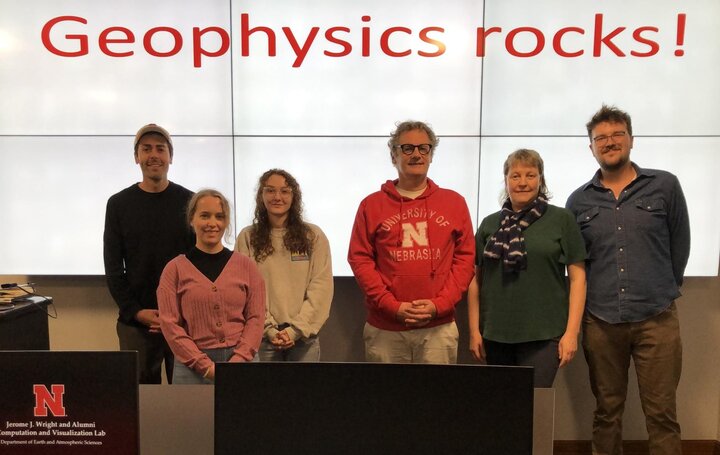Geophysics Research Group
Research Overview
The Geophysics Research Group exists at UNL since August 2016. Unlike many other geophysical research programs that focus on the application or development of a single geophysical method, our group utilizes the integrative approach in geophysical data analysis. We are looking for the answer (i.e. the geological model of the subsurface) that fits ALL available geophysical data and remains geologically valid. The data we use include seismic (reflections, refractions, earthquakes), gravity and magnetics; we also utilize any geological constraints that we can find, such as surface geology, well logs or tectonic restorations. The integration of multiple geophysical methods with all available geological constraints allows us to derive the most confident solution as it honors all the data.
Our group conducts research in four major directions:
- the tectonic study of passive continental margins (Gulf of Mexico, Nothern Atlantic and Tyrrhenian Sea)
- key tectonic structures in the Cascadia subduction zone and their role in the seismicity pattern along the margin
- origin and formation history of Bathymetrists Seamounts in the Central Atlantic Ocean
- near-surface geophysical studies in Nebraska
Tectonic history of passive continental margins (the Gulf of Mexico and Northern Atlantic)
This project started as an analysis of geological and geophysical data in the Gulf of Mexico toward understanding the tectonic history of the basin. We have developed a series of integrated geophysical models throughout the gulf that is based on the joint analysis of multiple geophysical datasets. The overall goal is to develop a set of geological constraints for the future tectonic restoration of the basin, such as the location of the Ocean - Continent Boundary (OCB), the location and thickness of the pre-salt sediments, the spatial extent of the Seaward-Dipping reflector (SDR) provinces on the conjugate margins, etc. The results can be found in the following papers: Filina. 2019; Liu et al., 2019; Filina et al., 2020b; Filina and Hartford, 2021; Filina et al. 2022; Filina and Beutel, in press. For conference presentations, please check our Publications.
In 2021, the project pivoted to the Northern Atlantic Ocean due to Dr. Filina's participation in the IODP Expedition 396 in the Norwegian passive continental margin. Like the Gulf of Mexico, the targeted Vøring and Møre basins show evidence of severe crustal thinning along with extensive volcanism followed by slow to ultraslow spreading, although the timing of that voluminous magmatic addition and its relationship to crustal thinning is poorly understood. The rock recovered from the drilling campaign will provide crucial constraints for the tectonic puzzle of the Northern Atlantic Ocean. As the current tectonic story of the Northern Atlantic is oversimplified with many unknowns, such as the extent of the Jan Mayen microcontinent, the nature of the crust under the Greenland-Iceland-Faroe Ridge (GIFR), a disagreement on the location of the ocean-continent boundary of up to 300 km between different authors, and mismatches in tectonic interpretation on conjugate margins, quantitative integration of various geophysical and geological data that will enable a more sophisticated and uniform approach to all regions of the study area. The project will leverage numerous existing and publicly available datasets to build a new comprehensive tectonic model of the Northern Atlantic from the GIFR in the south to the Voring-east-Greenland conjugate margins in the north. The resultant product will be a comprehensive tectonic reconstruction that will explain how this region evolved through time and how various continental fragments fit together prior to the Atlantic opening.
The project extended to the Tyrrhenian Sea in 2024 when Dr. Filina participated in the IODP expedition 402 to study the continent-ocean transition and mantle exhumation processes in the young and enigmatic Vavilov basin. UNL Geophysics will be involved in the integrated geophysical modeling of the entire Tyrrhenian Sea and the tectonic reconstruction of the Vaviolv basin. If you want to be involved in this project, please contact Dr. Filina.
Studying the Cascadia subduction zone
Dr. Filina participated in the NSF-sponsored 2017 Early Career Seismic Chief Scientist Training Cruise aboard the Research Vessel Roger Revelle. We have acquired 22 seismic lines in both oceanic and continental domains to map the subsurface structures over the Cascadia subduction zone. All lines have simultaneous gravity data records; some (not all) have magnetic measurements. The data were used in research projects of two graduate students (Asif Ashraf and Ariful Islam) and two undergrads (Khawl Al Farsi and Morgan Madsen).
Investigating the origin and tectonic history of Bathymetrists Seamounts in the Central Atlantic Ocean
Geophysics Research Group

This project is in collaboration with Dr. Christian Hübscher from the University of Hamburg. This study aims to reveal the origin of the chain of seamounts that trend obliquely to the known spreading direction of the central Atlantic Ocean. The University of Hamburg performed a geophysical survey over these seamounts in 2019 consisting of simultaneously acquired seismic and potential fields data to understand the nature of these seamounts. The team is currently looking for a graduate student to integrate different types of geophysical data to investigate the crustal architecture of the seamount province and evaluate different geological scenarios for the seamount formation.
Geophysical studies in Nebraska
We investigate the subsurface structures in Nebraska via integrating potential fields with earthquake locations and well data. We use spatial analysis of gravity, magnetics, and seismology to map the location of the buried basement faults in the state of Nebraska. The recent spike in recorded seismicity in central Nebraska - 27 earthquakes near Stapleton, NE from April to December 2018 – appears to be aligned with one of our interpreted subsurface faults. We plan to collect new geophysical data in 2024 in order to study that fault and explain what is causing that sudden spike in seismicity in central Nebraska.
In addition, we plan to conduct regular microgravity and seismic refraction measurements over the local aquifer to track the seasonal water variations with the support of the Daugherty Water for Food Global Institute.
Read more: